Planet View: N36°58.959’ E30°27.902’
Street View: N36°58.959’ E30°27.902’
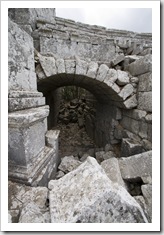
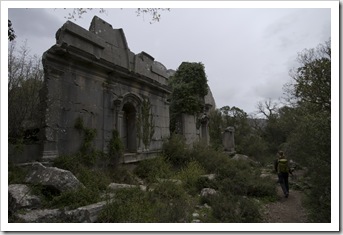
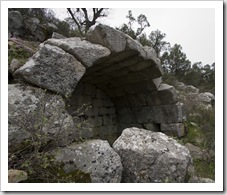 We ventured up into the Gulluk Dagi National Park yesterday to visit the lauded ancient ruins of Termessos. First a bit of history and specifics… The ruins are located in the Bey Mountains about 3300 feet above the Mediterranean. The Termessans, a Pisidian people, we thought to be fierce people prone to battling invaders and were known to have fought off Alexander the Great as far back as 333 BC. The Romans also respected the Termessan’s wishes to remain an independent society and treated them as allies in 70 BC.
We ventured up into the Gulluk Dagi National Park yesterday to visit the lauded ancient ruins of Termessos. First a bit of history and specifics… The ruins are located in the Bey Mountains about 3300 feet above the Mediterranean. The Termessans, a Pisidian people, we thought to be fierce people prone to battling invaders and were known to have fought off Alexander the Great as far back as 333 BC. The Romans also respected the Termessan’s wishes to remain an independent society and treated them as allies in 70 BC.
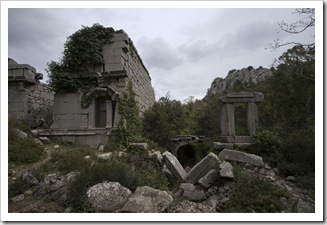
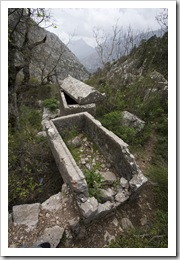 We teamed up with a couple of Hungarian diplomats on vacation from their four year posting in Belgium, we ran into the girls at our pansiyon after breakfast, which was convenient as we split the price of the taksi tour between us. The ride up into the mountains began with a by-the-seat-of-your-pants ride through the streets of Antalya with our Turkish taxi driver (who didn’t speak a lick of English). The highway into the Bey Mountains is absolutely beautiful, the mountains stretch skywards with ski resorts and snow capped peaks as far as the eye can see. Termessos itself is only around 30 kilometers from Antalya, then a 15 minute walk up a hiking trail to the lower city walls. The ruins are perched in-between two adjacent peaks with a steep descent down one side of the city and cliffs on the other. Its location no doubt made it a formidable location for invaders, we spotted quite a number of spots in the surrounding mountains where spots had been carved into the walls for lookouts and archers. We
We teamed up with a couple of Hungarian diplomats on vacation from their four year posting in Belgium, we ran into the girls at our pansiyon after breakfast, which was convenient as we split the price of the taksi tour between us. The ride up into the mountains began with a by-the-seat-of-your-pants ride through the streets of Antalya with our Turkish taxi driver (who didn’t speak a lick of English). The highway into the Bey Mountains is absolutely beautiful, the mountains stretch skywards with ski resorts and snow capped peaks as far as the eye can see. Termessos itself is only around 30 kilometers from Antalya, then a 15 minute walk up a hiking trail to the lower city walls. The ruins are perched in-between two adjacent peaks with a steep descent down one side of the city and cliffs on the other. Its location no doubt made it a formidable location for invaders, we spotted quite a number of spots in the surrounding mountains where spots had been carved into the walls for lookouts and archers. We 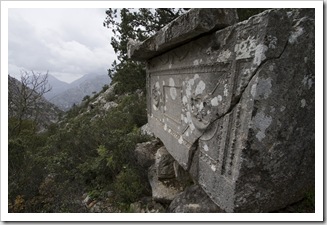 began our walk through the ancient city under the cover of clouds, which quickly turned to blue skies, then rain, and back to clouds all within about two
began our walk through the ancient city under the cover of clouds, which quickly turned to blue skies, then rain, and back to clouds all within about two 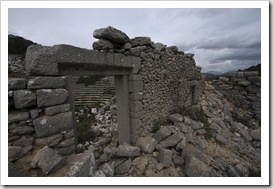 hours, an almost alpine climate where we were glad to have dressed in layers. The intricacy of the ruins really amazed us, considering that the city was constructed exclusively out of stone many thousands of years ago. The 4200-seat amphitheater was a sight to behold and the complexity of the water supply and cisterns was amazing. The city was complete with housing, a gymnasium, streets, a number of necropolis, baths and temples. We also found a few areas of the ruins, especially down the colonnaded street, where sections of wall were engraved with writings in the Termessans’ ancient script. The necropolis were quite a sight, too. The northeast necropolis is the burial ground in which we spent the most time, the size of the tombs and the amount of time it must have taken to construct them is mind-boggling. Termessos was really an awesome place to behold, we’re glad we made the trip.
hours, an almost alpine climate where we were glad to have dressed in layers. The intricacy of the ruins really amazed us, considering that the city was constructed exclusively out of stone many thousands of years ago. The 4200-seat amphitheater was a sight to behold and the complexity of the water supply and cisterns was amazing. The city was complete with housing, a gymnasium, streets, a number of necropolis, baths and temples. We also found a few areas of the ruins, especially down the colonnaded street, where sections of wall were engraved with writings in the Termessans’ ancient script. The necropolis were quite a sight, too. The northeast necropolis is the burial ground in which we spent the most time, the size of the tombs and the amount of time it must have taken to construct them is mind-boggling. Termessos was really an awesome place to behold, we’re glad we made the trip.
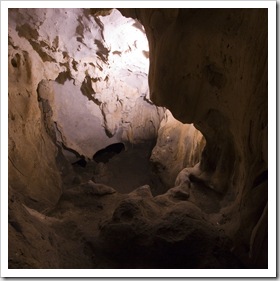
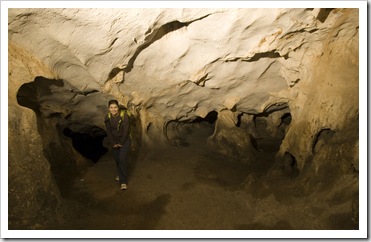 On the way back into Antalya we also ventured to the Karian Cave, about 12 kilometers from Termessos. Excavation and study of the cave began in 1946 and it’s heralded as one of the most important anthropological history sites in the world. It is thought to have been continuously inhabited for 25000 years! The cave is located at the end of a dusty road that winds through farmland off the side of the main highway, a steep hiking trail took us to the cave opening where we were free to venture into the cave unsupervised and uninhibited from touching the ancient writing on the walls. We both commented that we definitely wouldn’t be touching centuries old archaeological treasures in the States! The cave is split into two large chambers, definitely large enough to house scores of people, although I don’t think Lisa could have lived in there as she couldn’t handle the smell (surprise, surprise…) even for the short time we were inside!
On the way back into Antalya we also ventured to the Karian Cave, about 12 kilometers from Termessos. Excavation and study of the cave began in 1946 and it’s heralded as one of the most important anthropological history sites in the world. It is thought to have been continuously inhabited for 25000 years! The cave is located at the end of a dusty road that winds through farmland off the side of the main highway, a steep hiking trail took us to the cave opening where we were free to venture into the cave unsupervised and uninhibited from touching the ancient writing on the walls. We both commented that we definitely wouldn’t be touching centuries old archaeological treasures in the States! The cave is split into two large chambers, definitely large enough to house scores of people, although I don’t think Lisa could have lived in there as she couldn’t handle the smell (surprise, surprise…) even for the short time we were inside!
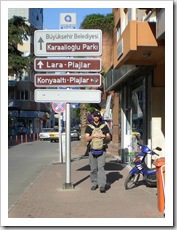
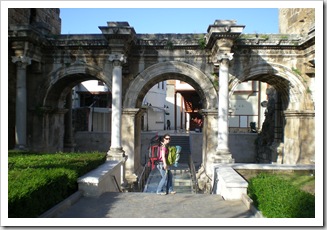 At the moment I’m sitting on the bus from Antalya to Fethiye (location N36°58.262’ E29°47.835’), winding through the Bey Mountains as we cross the peninsula between the two towns. Amazing views of snowcapped peaks in the distance and pine-covered gorges are visible out of both sides of the bus, just beautiful countryside and mostly uninhabited except for a goat herder here and there tending flocks in
At the moment I’m sitting on the bus from Antalya to Fethiye (location N36°58.262’ E29°47.835’), winding through the Bey Mountains as we cross the peninsula between the two towns. Amazing views of snowcapped peaks in the distance and pine-covered gorges are visible out of both sides of the bus, just beautiful countryside and mostly uninhabited except for a goat herder here and there tending flocks in 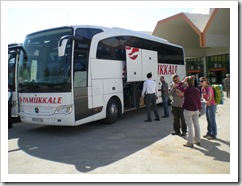 the steep ravines. The greenhouses we saw surrounding Antalya continued up in the mountains, we found out earlier today that Turkey supplies Europe with a significant portion of its tomatoes and it’s currently tomato harvesting season. We met up with a nice couple from Perth at our pansiyon this morning who have just hiked a 287 kilometer section of the Lycian Way between Fethiye and Antalya. Great to get some firsthand knowledge of the area to which we’re headed next. They’re sitting across the aisle from us on the bus, today they’re off to complete a 1200 kilometer trek through Spain after flying to London and changing planes to get back to Barcelona. The Lycian Way, which we hope to venture onto tomorrow or Saturday for a short hike, was just a warm up for them!
the steep ravines. The greenhouses we saw surrounding Antalya continued up in the mountains, we found out earlier today that Turkey supplies Europe with a significant portion of its tomatoes and it’s currently tomato harvesting season. We met up with a nice couple from Perth at our pansiyon this morning who have just hiked a 287 kilometer section of the Lycian Way between Fethiye and Antalya. Great to get some firsthand knowledge of the area to which we’re headed next. They’re sitting across the aisle from us on the bus, today they’re off to complete a 1200 kilometer trek through Spain after flying to London and changing planes to get back to Barcelona. The Lycian Way, which we hope to venture onto tomorrow or Saturday for a short hike, was just a warm up for them!
This entry was posted on Thursday, April 16th, 2009 at 10:47 AM and is filed under Turkey. You can follow any responses to this entry through the RSS 2.0 feed. Both comments and pings are currently closed.
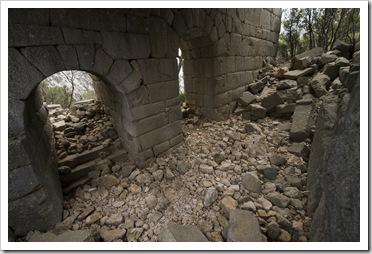
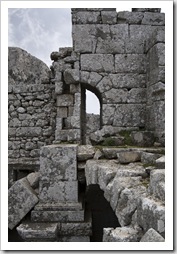

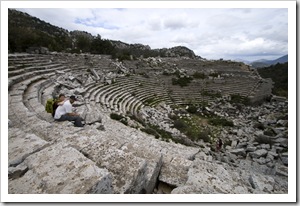
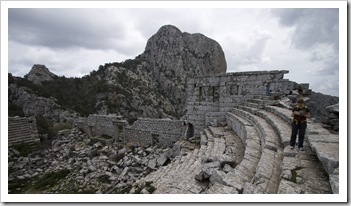
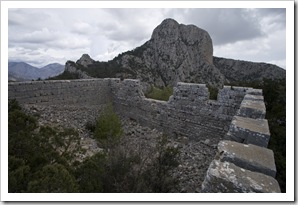
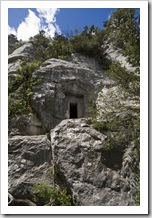
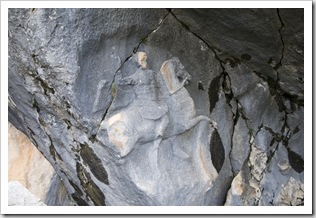
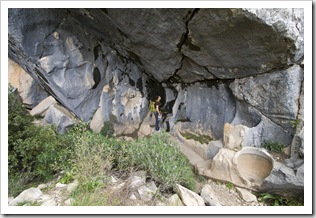
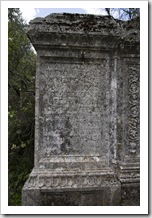
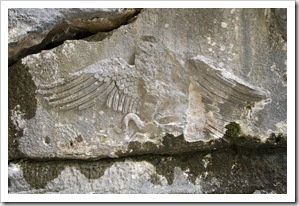
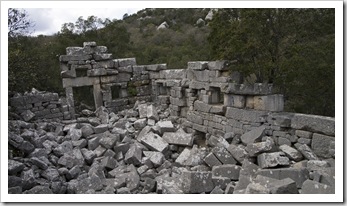
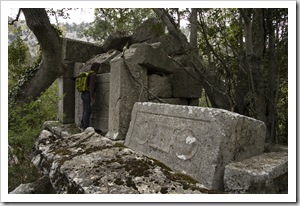
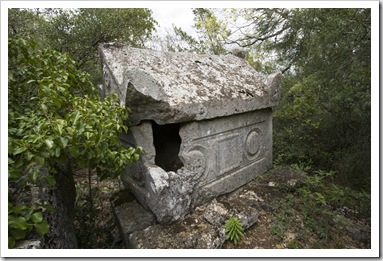
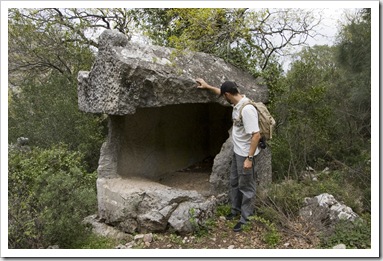
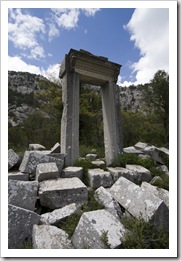
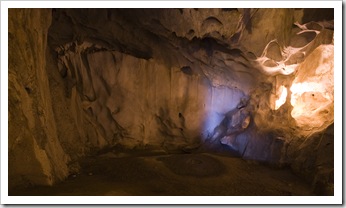
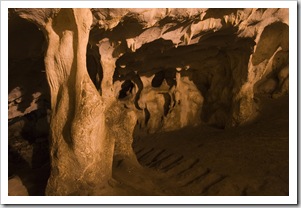
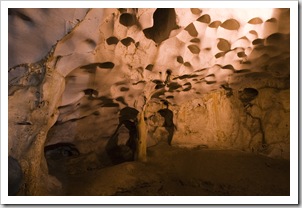
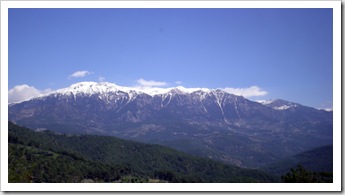

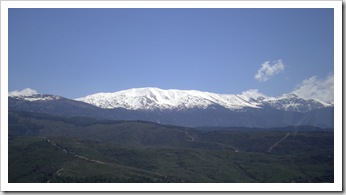

Hey guys. Keep those posts coming. I feel like I am riding along with you guys. What an adventure!!
April 16th, 2009 at 1:11 PM
Wow, thank you for this National Geographic tour, keep it up I really enjoy it, have fun John.
April 16th, 2009 at 4:11 PM
Your descriptions are great. Brings me back to my 1970 (ancient) travels thru Yogoslavia and Greece, which I thought at the time to be sooooo beyond any history I’d experienced. Your so much further back. I really love seeing the cave. Thanks for sharing.
May 2nd, 2009 at 8:05 PM